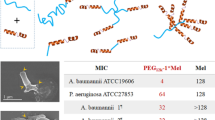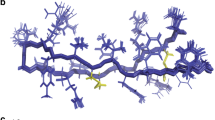Abstract
The rapid emergence of bacterial infections that are resistant to many drugs underscores the need for new therapeutic agents1,2,3. Here we report that six- and eight-residue cyclic d,l-α-peptides act preferentially on Gram-positive and/or Gram-negative bacterial membranes compared to mammalian cells, increase membrane permeability, collapse transmembrane ion potentials, and cause rapid cell death. The effectiveness of this class of materials as selective antibacterial agents is highlighted by the high efficacy observed against lethal methicillin-resistant Staphylococcus aureus infections in mice. Cyclic d,l-α-peptides are proteolytically stable, easy to synthesize, and can be derived from a potentially vast membrane-active sequence space. The unique abiotic structure of the cyclic peptides and their quick bactericidal action may also contribute to limit temporal acquirement of drug resistant bacteria. The low molecular weight d,l-α-peptides offer an attractive complement to the current arsenal of naturally derived antibiotics, and hold considerable potential in combating a variety of existing and emerging infectious diseases.
This is a preview of subscription content, access via your institution
Access options
Subscribe to this journal
Receive 51 print issues and online access
$199.00 per year
only $3.90 per issue
Buy this article
- Purchase on Springer Link
- Instant access to full article PDF
Prices may be subject to local taxes which are calculated during checkout



Similar content being viewed by others
References
Koplan, J. P. et al. Preventing Emerging Infectious Diseases. A Strategy for the 21st Century (US Department of Health and Human Services, Centers for Disease Control and Prevention, Atlanta, Georgia, 1998).
Khurshid, M. A. et al. Staphylococcus aureus with reduced susceptibility to vancomycin. Morbid. Mort. Week. Rep. 48, 1165–1167 (1999).
Pinner, R. W. et al. Trends in infectious diseases mortality in the United States. J. Am. Med. Assoc. 275, 189–193 (1996).
Bong, D. T., Clark, T. D., Granja, J. R. & Ghadiri, M. R. Self-assembling organic nanotubes. Angew. Chem. Int. 40, 988–1011 (2001).
Ghadiri, M. R., Granja, J. R., Milligan, R. A., McRee, D. E. & Khazanovich, N. Self-assembling organic nanotubes based on a cyclic peptide architecture. Nature 366, 324–327 (1993).
Boman, H. G. Peptide antibiotics and their role in innate immunity. Annu. Rev. Immunol. 13, 61–92 (1995).
Oren, Z. & Shai, Y. Mode of action of linear amphipathic α-helical antimicrobial peptides. Biopolymers 47, 451–463 (1998).
Andreu, D. & Rivas, L. Animal antimicrobial peptides: an overview. Biopolymers 47, 415–433 (1998).
Oren, Z. & Shai, Y. Cyclization of a cytolytic amphipathic a-helical peptide and its diastereomer: effect on structure, interaction with model membranes, and biological function. Biochemistry 39, 6103–6114 (2000).
Ghadiri, M. R., Granja, J. R. & Buehler, L. Artificial transmembrane ion channels from self-assembling peptide nanotubes. Nature 369, 301–304 (1994).
Granja, J. R. & Ghadiri, M. R. Channel-mediated transport of glucose across lipid bilayers. J. Am. Chem. Soc. 116, 10785–10786 (1994).
Kim, H. S., Hartgerink, J. D. & Ghadiri, M. R. Oriented self-assembly of cyclic peptide nanotubes in lipid membranes. J. Am. Chem. Soc. 120, 4417–4424 (1998).
Kim, H. S. Self-Assembling Cyclic d,l-Peptide Nanotubes as Synthetic Transmembrane Channels: From Chemical, Biological, and Practical Perspectives Ch. 3–4. Thesis, The Scripps Research Institute, La Jolla, California (1999).
Tosteson, M. T., Holmes, S. J., Razin, M. & Tosteson, D. C. Melittin lysis of red cells. J. Membr. Biol. 87, 35–44 (1985).
Sims, P. J., Wasggoner, A. S., Wang, C. H. & Hoffman, J. F. Studies on the mechanism by which cyanide dyes measure membrane potential in red blood cells and phosphatidylcholine vesicles. Biochemistry 13, 3315–3330 (1974).
Waggoner, A. S. Dye indicators of membrane potential. Annu. Rev. Biophys. Bioeng. 8, 847–868 (1979).
Loew, L. M. Characterization of potentiometric membrane dyes. Adv. Chem. Ser. 235, 151–173 (1994).
Friederich, C. L., Moyles, D., Beveridge, T. J. & Hancock, R. E. W. Antibacterial action on structurally diverse cationic peptides on gram-positive bacteria. Antimicrob. Agents Chemother. 44, 2086–2092 (2000).
Amsterdam, D. in Antibiotics in Laboratory Medicine 3rd edn (ed. Lorian, V.) 53–105 (Baltimore, 1991).
Seebach, D. et al. Cyclo-β-peptides: structure and tubular stacking of cyclic tetramers of 3-aminobutanoic acid as determined from powder diffraction data. Helv. Chim. Acta 80, 173–182 (1997).
Clark, T. D., Buehler, L. K. & Ghadiri, M. R. Cyclic β-peptide nanotubes as artificial transmembrane ion channels. J. Am. Chem. Soc. 120, 651–656 (1998).
National Committee for Clinical Laboratory Standards. Methods for dilution antimicrobial susceptibility tests for bacteria that grow aerobically 4th edn M7-A4 (NCCLS, Villanova, Pennsylvania, 1997).
Acknowledgements
We thank M. Couto for his guidance and assistance with the in vivo studies. We are also grateful for the predoctoral fellowships from the Skaggs Research Institute and the Spanish Ministry of Education (S.F.-L.), and postdoctoral fellowships awarded by the Fulbright Program (G.V.L.), National Institutes of Health (D.A.W.), Swiss National Science Foundation (K.K.), and the Spanish Ministry of Education (M.D.). This work was supported by a grant to M.R.G. from the National Institutes of Health.
Author information
Authors and Affiliations
Corresponding author
Rights and permissions
About this article
Cite this article
Fernandez-Lopez, S., Kim, HS., Choi, E. et al. Antibacterial agents based on the cyclic d,l-α-peptide architecture. Nature 412, 452–455 (2001). https://doi.org/10.1038/35086601
Received:
Accepted:
Issue Date:
DOI: https://doi.org/10.1038/35086601
This article is cited by
-
Cholesterol-stabilized membrane-active nanopores with anticancer activities
Nature Communications (2022)
-
Antimicrobial effects of syndiotactic polypeptides
Scientific Reports (2021)
-
Attenuated total reflection-Fourier transform infrared spectroscopy: a tool to characterize antimicrobial cyclic peptide–membrane interactions
European Biophysics Journal (2021)
-
Molecular engineering of antimicrobial peptides: microbial targets, peptide motifs and translation opportunities
Biophysical Reviews (2021)
Comments
By submitting a comment you agree to abide by our Terms and Community Guidelines. If you find something abusive or that does not comply with our terms or guidelines please flag it as inappropriate.



